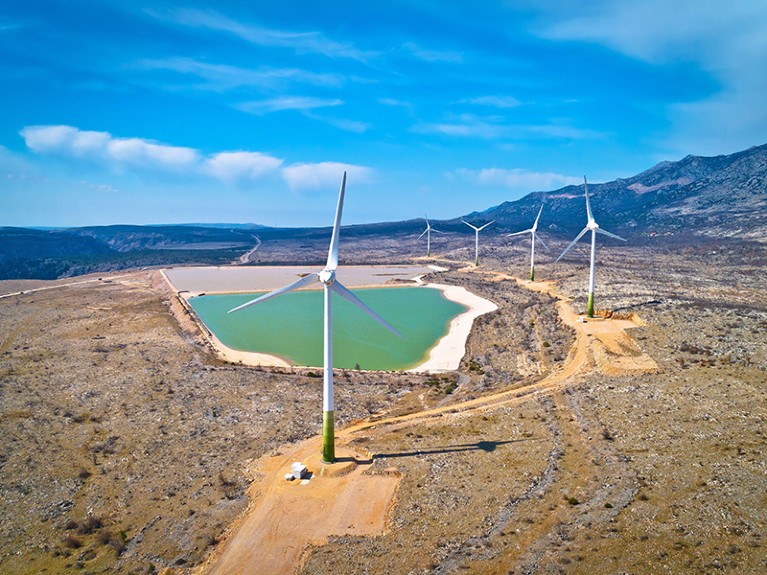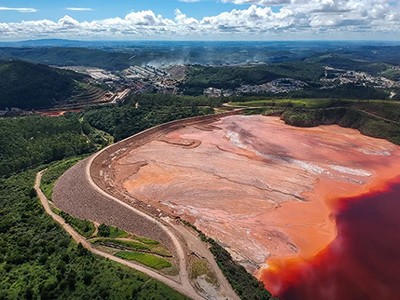
This year’s Queen Elizabeth Prize recognized a 40-year partnership between two researchers that has led to an increase in the size of modern wind turbines and the scale of their use.Credit: Alamy
Last month, materials scientist Matic Jovičević-Klug and his colleagues reported how ‘red mud’, an iron oxide waste product generated during aluminium manufacturing, can be repurposed for ‘green’ steelmaking. Their findings1 have the potential to reduce carbon dioxide emissions from steelmaking by using a circular-economy approach.
Had an article reported the implementation of this same process on a larger, even industrial scale, many readers might have been surprised to see it in Nature.
Well, we want to change this perception.
Iron extracted from hazardous waste of aluminium production
We want the world of engineering to know that its research, whether as a proof of concept or at the implementation stage, will be considered by Nature’s editors and reviewers, as it is already by colleagues at other Nature Portfolio journals. The most recent of these, Nature Chemical Engineering and Nature Reviews Electrical Engineering, were launched in January.
We are proud to have already included some notable examples in Nature’s pages. On 31 January, for example, Zhixun Wang at Nanyang Technological University in Singapore and his colleagues described a method to produce flexible semiconductor fibres without defects or cracks that could be used in wearable devices2. One advantage of this technology, write Xiaoting Jia and Alex Parrott in an accompanying News and Views article3, is its industrial readiness, because the semiconductor fibres can be woven into fabrics using existing methods.
So why emphasize our willingness to consider more such studies now? Last summer, Nature published a series of editorials on the Sustainable Development Goals (SDGs), the world’s plan to end poverty and achieve environmental sustainability. The plan isn’t going well — most of the goals and associated targets will not be met by the United Nations’ self-imposed 2030 deadline.
Progress towards the Sustainable Development Goals
The series brought home the realization that SDG-related research is not yet a priority for many researchers, especially for those in high-income countries, compared with their colleagues in low- and middle-income countries. Partly in response, more than 40 Nature Portfolio journals put out a collective call for papers on topics relevant to the SDGs as part of a drive to get researchers thinking about how their work might move the world closer to meeting the goals.
In this context, studies that show how discoveries and inventions can be applied in real-world settings, including by testing and evaluating products and processes on large scales, are often highly relevant to the Nature Portfolio journals. Nature’s publishing criteria require that papers report original research that is of outstanding scientific importance. The journal also expects that a study reaches “a conclusion of interest to an interdisciplinary readership”. Our message is loud and clear — that readership includes engineers, as well as scientists from all disciplines.
Back to the future
By putting out this call for more engineering research, we are restoring a connection with engineers and the field of engineering that is rooted deep in Nature’s history. In Nature’s first issue, published on 4 November 1869, readers will find a discussion on the likelihood of silting in the Suez Canal4, one of the largest engineering projects of the nineteenth century. The canal was a hot news topic, because it was due to open two weeks later, on 17 November. There was much public debate, and a degree of anxiety about such geoengineering feats. A correspondent to Nature, Thomas Login, had worked on the 437-kilometre Ganges Canal, which had opened 15 years earlier to connect the Ganges and Yamuna rivers in India. The Ganges Canal’s waterways were intended to irrigate massive stretches of farmland, thereby reducing the risk of famine in a region where people had previously experienced hunger when the rains failed. I have no doubt there are many who will say the Suez Canal “is a total failure”, Login wrote. He was confident that the canal would succeed.
This is not an isolated or rare example. Subsequent editions of Nature include engineering conversations and critiques. The journal also published regular reports of meetings of professional engineering societies — just as those of other scientific societies were discussed.
The late nineteenth century was an age of ambitious, and controversial, imperial-era projects. It was also a time when scientists and engineers wanted to read about each other’s work in the same journal. As editors and publishers, we accept our share of responsibility for how things have turned out. Our responsibility now is to renew this connection.
Creating by collaborating
We want to recognize engineering in other ways, too. By highlighting the profession’s approach to collaboration, for example. Last week, the Queen Elizabeth Prize for Engineering, equivalent in recognition to the Nobel prizes, was awarded to two engineering researchers for their contributions to the field of modern wind-turbine technology. Unlike recipients of some of the more well-known science prizes, Andrew Garrad and Henrik Stiesdal were not rewarded for a single landmark achievement, but for their 40-year partnership in designing, testing and improving wind turbines that are now built on an industrial scale around the world. The prize recognizes decades of painstaking, sometimes incremental, and, yes, collaborative achievements.
Their work also brought together researchers from other fields, such as mathematics, fluid physics, electronics and materials science. Such an approach to problem-solving needs to become the norm if the world is to succeed in addressing global challenges, Stiesdal, a former chief technology officer at Siemens Wind Power, told Nature. We wholeheartedly agree.
Engineering and science are like two ships that have set sail close together, but in many ways have gradually drifted apart. We can’t let that continue. Having engineers back in Nature’s pages is long overdue, not least for the health of our planet and the well-being of all people.

 Progress towards the Sustainable Development Goals
Progress towards the Sustainable Development Goals
 Iron extracted from hazardous waste of aluminium production
Iron extracted from hazardous waste of aluminium production
 Toxic red mud could be turned into green steel
Toxic red mud could be turned into green steel


